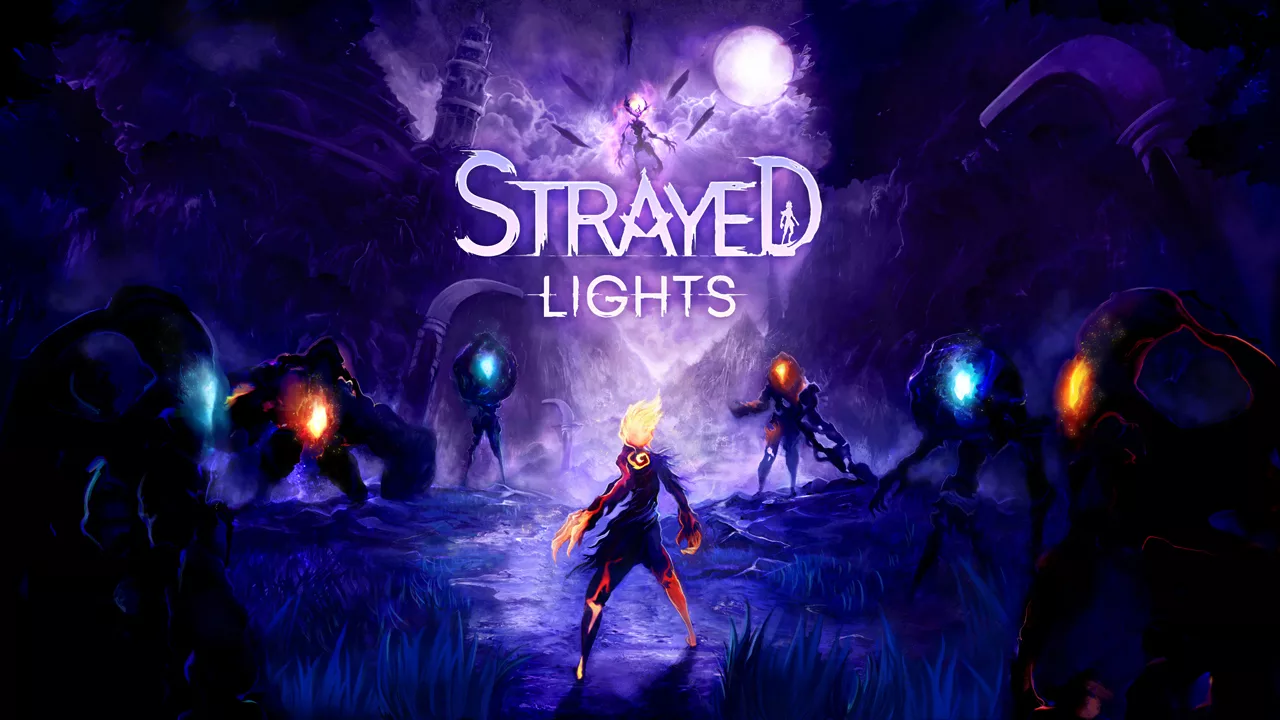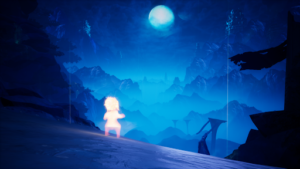Written by Paul Tyre
Introduction
If you are looking for an indie action adventure game, Strayed Light as described on the tin, may be the game for you. For me, Strayed Light immediately piqued my interest based on its interesting colour mechanic, art style and a short completion time, which means it won’t linger in my library too long. I often feel with modern games, particularly AAA titles, that I dread starting them when I know I have 60+ hours to commit, so with Strayed Lights having a 4-5 hour playtime on “How Long to Beat”, I was hopeful this would be a game that wouldn’t overstay its welcome.
Born to survive
Strayed Light sees you taking control of a main character at birth, learning to crawl, walk and then run in the opening sequence. Born into a dark terrifying world of mystery and danger, you lead your infant character on a journey through lightning into the unknown until you reach a crystal-like wall where your character reaches out and touches it. Suddenly you are all grown up, like the crystal wall was an evolutionary stone raising you to your adult potential. Before you can enjoy being all grown up however, you are met by a shadow self, your inner conflict, and you must learn to fight and most importantly, defend yourself from this cruel existence.
The overall feel of Strayed Light is similar to that of the dark unforgiving world in the Ori series. Strayed Light is a 3rd person action adventure however, rather than the previously mentioned action platformer. Immediately I was surprised with one interesting element the game delivered, which was its use of the vibration in my Xbox Elite Series 2 controller. This is a feature I would have never have guessed I would be complimenting, but the use of the vibration in different areas of the controller to display heartbeats and lightning strikes caught me off guard, and really highlighted to me how underused rumble features are in most other games.
Additionally, the game has no verbal or written narrative, yet I did not feel that this caused the narrative to lack in any way as the story is told through cinematics, gameplay experience and music.
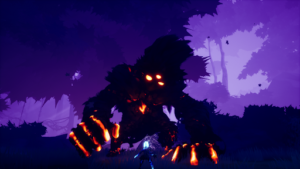
Gameplay
Strayed Lights offers interesting and compelling gameplay through its utilisation of a range of different mechanics, gameplay style and a strong storyline.
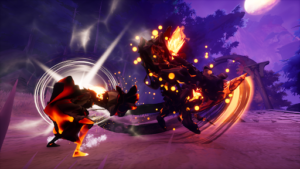
Combat
Combat is a key element of your survival and one of the few points of interaction. As opposed to many other games you may have played, in Strayed Lights your focus will unlikely be an all out attack approach. In this game you will instead be defending yourself through parrying enemy attacks before throwing a final blow and defeating them. This is a fun and at times difficult task to manage when facing multiple enemies, however when getting a combo from parrying attacks, it was hugely satisfying making my character feel untouchable for a moment before being walloped by an enemies unblockable attack.
Although the main principle is to parry attacks, you are able to use basic attacks and unlock abilities that allow you to do some damage, but ultimately the goal is to dodge and defend yourself from incoming blows. When using the parry feature, you are given the option to cycle through two colours, red and blue. The red and blue are effectively indicators of a different stance for your character, but also for your enemies. As enemies attack, they too will switch stance and in order for you to defend yourself effectively you must also adapt to what their colour is.
In practice the colour mechanic is fun to learn and is a creative way to represent stance, however it is not enough to make the combat of basic enemies feel entertaining in the long run. Enemies can be blocked, dodged and fought with very little movement. What I mean by this is that you can remain still on the spot, let an enemy attack you and press the parry button to block their attacks. This left me feeling very static, and although I purposely moved to make the fights feel more interesting, it isn’t ideal that I as the player had to make the game feel better.
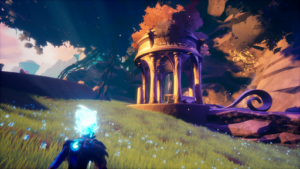
Explorable World
The general movement and mechanics of the game work well, with some basic platformer areas and semi-open world sections to explore but alongside static combat when facing basic enemies, the game world feels empty and enemy encounters feel random and out of place. I would have preferred having minor enemies that filled the areas, such as the spider-like creatures seen in the first section of the game. With more minor enemies the areas could have felt more living and dangerous to cross. Instead the large enemies felt like a task aimlessly standing there awaiting your arrival. The open world area looked amazing with some really nice visuals that complimented the art style of the game, however this was not enough to ensure an entertaining experience long term. The saving grace of these areas were that the game has a short playtime, meaning you can sprint through these sections to get to the boss fights quicker.
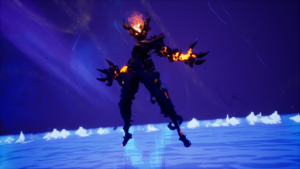
Inner Mind
The Inner Mind is a plane of existence where you can go to fast travel and to spend skill points that you earn through playing. The skill tree is fairly basic with a handful of options giving you access to upgradable character abilities and perks. I always appreciate RPG-like options in games as it allows me to feel like my character is customised to my playstyle. It also allows me to take my time in learning new combat moves so I do not feel too overwhelmed at the beginning of the game. I find it much more satisfying when I master an attack style and then move on to the next, rather than having it all thrown at me at once, so for me, this was perfect.
The fast travel style system is accessed here as well, displayed by portals that you can go through to traverse to the main centred area of the game or to a checkpoint in an area you were already exploring. This is a simple way to travel, however it can be confusing to know which portal is the one you are wanting to go through at first as there is no clarity other than you can see the general area through said portal.
The Inner Mind area was an interesting idea but for me it was disruptive to the main gameplay. When traversing the world, you will gain skill points and when you get enough to upgrade a skill you will be prompted to access the Inner Mind. When you do this, you are brought to the alternative plain and separated from the area you were in. Although you can return to the area you were in, it does not tend to return you to the place that you left, and instead you will spawn from a checkpoint-like location. I personally found that this ruined the flow of the gameplay and led to me no longer going into the Inner Mind until I had finished an area.
Boss Fights

To be clear, combat is not entirely bad or unentertaining and this is very much proven by the epic boss fights in the game. These encounters contradict all of the underwhelming combat in the open areas and shed a light on how good this game can be. You will find yourself analysing each boss’s combos to be able to deflect and defend yourself from their incoming attacks in a fun and high stakes battle to save your fellow siblings. For each boss there is more than one round of fighting as well which helps drive the story and bring diversity to each fight.

Story time
Starting from birth and fighting for life, the story of Strayed Lights is told wonderfully. The achievement of producing a compelling tale with no narrative and no explanation is something the team at Embers Games should be proud of. As the story developed I found myself compelled by the feeling of mystery, driving me to find out what happens next and the addition of interactive cutscenes at the end of boss fights helped this along nicely, offering a great transition between moments of action to moments of story development. Ironically the interactive scenes and cutscenes are what make the rest of the gameplay feel a bit bland, which left me choring through the explorable sections to get to the next boss fight and cutscene.
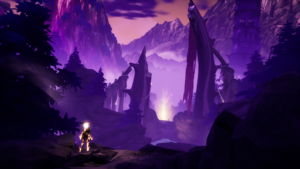
Conclusion
Strayed Lights was the perfect filler title I needed in my library. With a beautifully directed story, fantastic boss fights, a great soundtrack and interesting mechanics, the game really delivered a positive experience. The game world feeling derelict and the standard enemy fights feeling staged with poor substance were the areas where the game lacked for me. This however, did not take away from the overall gameplay experience due to the short length of the game. Strayed Lights is an enjoyable experience. Did it have the potential to be better? Absolutely. But it does not take away from the great time I had playing it and I imagine many others will too.
Overall
-
CX Score - 68%68%
Summary
Pros
- Colour based stance is a fun and unique addition
- Brilliantly presented story
- Boss fights are top tier
Cons
- Open areas of game world feel empty
- Standard enemy fights felt repetitive and static
- Odd controller scheme

